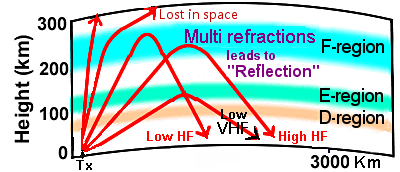
 What are HF Band Conditions?
What are HF Band Conditions?
HF band conditions refer to the quality and reliability of HF radio signals transmitted between two points via the ionosphere, influenced by factors such as time of day, location, season, solar flux, and geomagnetic storms. The ionosphere absorbs, refracts, and reflects HF radio frequencies (3 to 30 MHz), depending on the region through which the radio wave travels.
During the day, the ionosphere is usually denser and higher in altitude, refracting radio waves back down to the Earth’s surface, allowing for longer-distance communication using the higher ham bands (14 MHz and above). At night, the ham bands below 15 MHz are significantly more effective. See an explanation here.
Other factors that can affect HF radio propagation conditions include the solar cycle, which influences the amount of ionizing radiation reaching the ionosphere, as well as geomagnetic storms and solar flares, which can disrupt the ionosphere and affect radio wave propagation.
Overall, HF radio propagation conditions can be unpredictable, requiring radio operators to be responsive while maintaining an effective strategy for communication over long distances.
shows near-real-time indices and explains what the terms mean.
